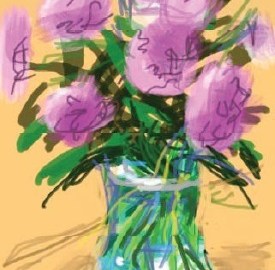At Your Fingertips: David Hockney’s iPad Art

Apparently you can teach some old dogs new tricks. In a piece by Digital Planet producer Colin Grant, artist David Hockney discusses his love affair with his iPhone and iPad and how he uses those new technologies to create art (such as the example above). In a new exhibition titled Fleurs fraiches (“fresh flowers”) at La Fondation Pierre Bergé–Yves Saint Laurent in Paris, France, Hockney displays these new works together for the first time. It’s fascinating to watch such an established artist venture forth in a yet-to-be-established medium, lending it the “street cred” that it so sorely needs to combat critics who still cling to the old media as the only “true” art. Working directly with his fingers on the interfaces of his devices, Hockney brings art not only from his fingertips, but also puts it just a fingertip away for the viewer.
Hockney has worked with computer-based art for the past 20 years. Only recently, however, has he felt that the technology could keep up with the speed of his mind setting up the next gesture or stroke. That speed also comes into play in the process of getting feedback. “You can make a drawing of the sunrise at 6am and send it out to people by 7am,” Hockney gushed to Grant in the interview. That nearly instantaneous process of production and critique allowed Hockney to produce hundreds of drawings. The same furious dynamic of speed and free access comes to the exhibition itself as the works are displayed on iPads around the gallery, which are “refreshed” frequently to produce new drawings of flowers for viewing. Thus, the flowers live up to the “fresh” label in every sense.
“Who wouldn’t want one?” Hockney told Grant at the opening of the Paris show. “Picasso or Van Gogh would have snapped one up.” Thus, Hockney positions himself as following in a tradition of innovators taking advantage of the latest technology. The Impressionists, for example, could never have worked in the great outdoors without the benefit of mixed paint in tubes. Changes in the chemistry of mixed paint allowed for a thicker consistency, which Van Gogh and others put to good use in their impasto techniques. Hockney’s interest in art and technology goes even further back to his time with physicist Charles M. Falco developing the theory that artists such as Caravaggio used tools such as the camera obscura, camera lucida, and curved mirrors to achieve a level of realism impossible using pure draftsmanship. In that 2001 book, Secret Knowledge: Rediscovering the Lost Techniques of the Old Masters, Hockney essentially accused the Old Masters of deception at the very least and cheating at the very worst. At least with his open adoption of the Apple-based technology, Hockney can never be accused of deceiving or cheating the public.
I found it interesting that the right-handed Hockney actually uses his left hand when working on a touch screen. He finds the switch gives his works a different quality that his stronger hand could not. Renoir could paint with either hand so fluidly that experts struggle to tell the difference. Lefty Lovis Corinth suffered a stroke in 1911 that forced him to paint right-handed for the rest of his life. That life-changing event marks a drastic difference in Corinth’s art stylistically. I wonder if Hockney actually fears the combination of his speedy dominant hand and the speed of the technology. Working with his off hand may be Hockney’s way of giving himself a handicap—an obstacle to keep the free-wheeling nature of this new medium from wildly veering completely off the tracks.
Perhaps this exhibition will serve as some kind of historical marker in which digital technology finally came of age and found a fitting champion from the old school. Hockney’s a big enough name to be considered an Old Master of modern art. By lending his gravitas to the almost unbearable lightness associated with the quicksilver media of iPads and iPhones, Hockney allows his credibility to rub off not only on the medium itself, but also on those lesser-known practitioners who hope to one day fill galleries (perhaps virtual ones) someday. Just as the Impressionists brought their fresh flowers from the fields to the galleries and changed the course of art history, perhaps Hockney’s digital fresh flowers will do the same.





